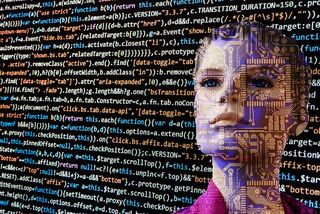Artificial Intelligence
Interpreting your partner is harder than you imagine!
Why interpretation is central to so many bitter conflicts.
Updated February 26, 2024
Imagine this: you’re on a dating game show and there are three singles behind a curtain. You can ask the three people anything you want to know, but so that their voices don’t sway your decision, they text their answers to the show’s host, who reads them out. Who would you pick to go out with?
The YouTube show Mind Field tried this but, unbeknownst to the female participants on the fake game show, bachelor No. 2 was secretly an artificial intelligence chatbot!

The chatbot’s answers were often absurd. To the question “What would you cook me for dinner?” it replied, “Roasted bagels.” To “Describe your clothing style,” it responded, “They are made of cloth and have colors.”
But because the women were lacking key information—they didn’t know they were talking to an AI—they read into the answers and constructed a whole story about a complex personality on the other side of the curtain.
One of the women called bachelor two, “a little sassy” and two of them said he was similar to their ex-boyfriends. Although the chatbot’s answers were only barely coherent, the women said “he” was: playful, mysterious, a little into himself, a man-child, and hilarious.
Amazingly, two of the four women chose to go on a date with the AI over either of the human bachelors. One said, “I think he might be the weirdo that I’m looking for.”
So much of what we believe about a person (or even a non-person) depends not on them, but on us.
We take mental shortcuts and categorize and this helps us to make sense of a tremendously complicated world. But it has drawbacks too. As this fake game show illustrates, we can even invent a whole way of understanding someone that has nothing to do with reality.
This fact is incredibly important for conflicts, especially since many are now playing out online where we don’t know the people we’re in conflict with (if they are people and not bots), and can readily make harshly critical interpretations of their identities and motivations.
I like photography. Imagine you happened to walk up and see me (a white man) taking this picture.

You might interpret what you saw in many ways:
- A photo of an Asian person being taken by a white person.
- The continued control of Asian bodies by whites: an expression of colonialism and violence.
- A tokenistic attempt by a white photographer to appear to care about diversity.
- The celebration of an Asian subject: an inclusive centering of Asian people who have too long been underrepresented and marginalized.
- A photo taken of fruits while someone was shopping.
- Documenting the disgusting and unnatural practice of dying one’s hair.
- A photo being taken of a person with a mask on (who happens to be Asian).
- A man being predatory and sexualizing a woman: an example of patriarchy and rape culture.
- A photographer stealing someone’s image without their consent.
- Standard behavior of someone socialized into the professional class.
- An artist freely capturing a moment in time.
- A grown man wasting his time with an expensive toy.
- Some fruit, a street, several buildings, a sidewalk, some people, some cars…
- A man sublimating his unconscious murderous impulses into the use of a camera (a symbolic gun).
- A spy using a top-secret mind-reading device that looks, deceptively, like a camera.
- A vast quantity of atoms moving in particular ways.
We could go on and on with these. Some may sound more plausible than others, but most are actually surprisingly difficult to verify or falsify.
Whatever interpretation you state, if I disagree, how will we know who’s correct? I could theoretically have any subconscious motivation whatsoever, so I don’t necessarily know what my true motivations are, but then neither do you.
That makes many of these interpretations fertile ground for bitter conflicts, in particular because this simple scene involves sensitive issues like race, identity, and individual freedoms.
Without more information, how would you know which interpretations to make? And would that lack of information stop you from judging the scene, even in very negative or moralistic ways?
The last interpretation may be technically correct, but it takes the scene to such a complicated level of detail that it’s impossible to understand. Since we’re not super-computers, people can’t deal with the amount of data needed to describe what happened at the atomic level. We have to round off some of the complexity, to zoom out so we can talk in less precise ways.
But each of us will have different preferences about how far to zoom. You may consider the scene in terms of events that happened centuries ago and their impacts up to the present day, while I’m just thinking about what shutter speed to use on my camera. Depending on how we communicate, these differences could turn ugly very quickly.
Maybe you read over the above interpretations and shook your head at some: “That’s crazy!” Maybe you read one and thought, “That’s obviously true.”
In either case, it’s helpful to know that there are people who are just as thoughtful as you are who make different interpretations. Any time you find yourself laughing off someone else’s beliefs as absurd, chances are high that you haven’t figured out the reasons behind their thinking.
Here’s another question: how important is this scene? That depends in large part on your point of reference (“important” compared to what)? Inevitably, our judgment here is based largely on other people’s judgments, so a whole network of previous assumptions and interpretations props up the one we choose to make.
These judgments are to an extent cultural and ever-shifting. One review found that interpretations of events as harmful have expanded over time. So for example, today far less severe instances, and a wider range of events, get interpreted as abuse.
This matters because, on any topic whatsoever, we can find popular theories that help us to understand the world. They do this in part by encouraging us to look for evidence that they’re correct, and to reject other framings and contradictory evidence.
But in particular when we have very little data to go on, like the single event here (knowing nothing about what my conscious intentions are, what I plan to do with the picture, if I take lots of pictures like this with different people in them or if I have a pattern of only taking pictures of people who wear glasses, or Asian people, or women…), it’s very easy to make an interpretation that is both not that useful in describing the situation, and impervious to correction.
Any attempt I make to counter your interpretation might even be rejected as further evidence of my defensiveness and bias. That’s what’s called a Kafka trap, where a claim of innocence is held up as more proof of guilt.
You say, “Cameras and guns are both pointed at targets, so it’s obvious you were expressing an unconscious murderous tendency.”
I reply, “I didn’t want to kill her though.”
You counter, “Of course you would deny that you wanted to kill her. That’s exactly what happens when you force your murderous desires into your unconscious!”
To address destructive conflicts, it helps if we can define our theory about what’s happening specifically enough that we can have a conversation about exactly what we mean. What would be better still is if we’re so precise that we can test our theory and try to prove it false, not just look for ways to seem to support it, or to only interact with those who agree with it.




